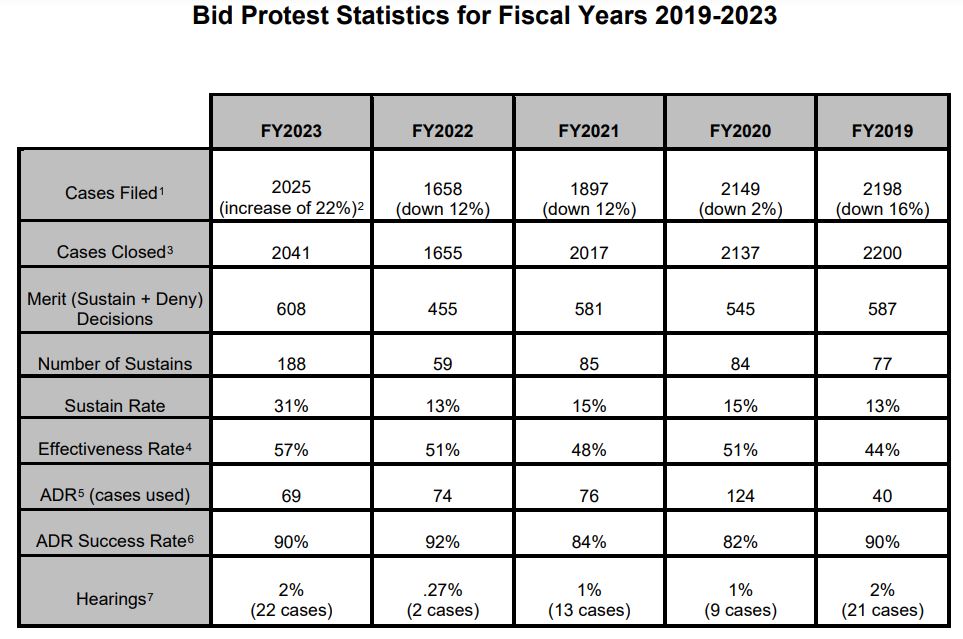Better data protests could benefit, agencies, vendors alike
When it comes to data on bid protests, the data is lacking to say the least.
Beyond the annual bid protest report to Congress from the Government Accountability Office, agencies track few other outcomes from protests.
David Drabkin, a fellow at the Stevens Institute of Technology Acquisition Innovation Research Center and a former senior procurement executive for the General Services Administration, said by not collecting and understanding this data, agencies are missing a host of opportunities to improve the acquisition process, the contracting workforce and industry response to solicitations.

“The protest process is important to manage the procurement process. But we don’t take advantage of access to the data, which allows us to understand whether there’s a place in our process that needs our immediate attention, whether it’s training, whether one of our rules is defective and needs to be rewritten. We don’t have that ability to do that from our desktops. The only time your attention really gets drawn there is when there’s a big case that makes the news or Congress gets upset and starts summoning you or your boss to the Hill to explain why something happened,” Drabkin said in an interview with Federal News Network. “So instead of being able to manage on a proactive basis using the data, which by the way they already collect, they just don’t put it in a place where they can use it. They just don’t have a way to proactively manage when there are trends in problems that manifest themselves in the protest process.”
Drabkin and Chris Yukins, a professor at the George Washington University law school and a fellow with Acquisition Innovation Research Center, led a research effort over the last year, which Congress required in the 2022 Defense authorization act, to review and analyze what Defense Department protest data is available, specifically around agency-level protests, and how the Pentagon is using it to improve acquisition processes.
Drabkin, Yukins and their team issued a report earlier this year outlining six major findings and made eight recommendations to improve the agency-level bid protest process.
But while the report’s findings focus only on DoD, the lack of data, the minimal use of agency-level protests and the ability for all parties involved to improve is a universal theme that emerged from this research.
“When we looked at the whole process, we also talked to the procurement executives within the department. I think it’s important to know that all of them thought that having a bid protest process was really important, and they liked the idea of an agency level bid protest process because it looked less expensive and faster in terms of allowing the purchase to proceed,” Drabkin said. “But they, too, didn’t have the data on what was really going on with protests at any level. They get a report about how many GAO cases there were. They might get that report once a year. GAO publishes its statistics in the beginning of the new fiscal year, normally, but they don’t have a complete view of the protest system from the Court of Federal Claims down to the agency level bid protest process. They also don’t have the current data provided to them to allow them to identify problems in the procurement process, which are manifesting themselves, and contractors who are unhappy with how the government is managing the acquisition process. They pay a lot of money for the protest process in terms of what comes out of salaries and budget and time to take delivering products and services to their customers internally. But what they don’t have is right now available to them at their fingertips on their computers, the ability to see trends where there may be a problem with a part of the procurement process. Did they did they identify the requirement correctly? Did they have good performance measures for both for evaluating offers before they make the award and post award for measuring whether they actually got what the government paid for?”
The most recent GAO bid protest report to Congress for fiscal 2023 shows a 22% increase in the number of cases filed. GAO acknowledged a big reason for the increase is the large number of complaints challenging a single procurement, the Chief Information Officer-Solutions and Partners 4 (CIO-SP4) from the National IT Acquisition and Assessment Center (NITAAC).

In addition to GAO, obtaining data from the Court of Federal Claims isn’t easy. While the court captures bid protest data, it doesn’t necessarily make it easy to find or analyze, and there is no centralized data on agency-level protests.
Drabkin said the data from GAO, however, doesn’t tell the entire story about protests.
“GAO considers ‘winning’ when the government either awards a contract to the protester or takes corrective action resulting from the protest. When you ask them, ‘well, how many protesters actually wind up getting the contract they filed a protest on?’ The number is, I don’t know, 6% or 10%. It’s not the 40-plus percent, they quote as winning because they count the corrective action as winning,” he said. “If you’re a protester, and you’re trying to figure out whether it’s worth your investment and your money to file a protest, I think it’s pretty important to know what the likelihood is that you will actually get a contract because you may spend a lot of money. You may wind up getting a decision that the government didn’t follow on its rules, but you may not get the contract. I think it’s pretty important to understand what it means to file a protest and when. And that’s true for whether it’s at the agency level, GAO level and with a Court of Federal Claims level.”
The research group’s recommendations mostly focused on how to improve the agency-level protest process, including formalizing the role of the “agency protest official,” and to publish data on agency-level protests, including, potentially, the decisions themselves to reinforce regularity and confidence in the acquisition system.
Drabkin said agency-level protests would gain more traction if it was a one-and-done type of complaint, meaning the vendor couldn’t also file with GAO or the Court of Federal Claims if they lost. Additionally, departments would see benefits from agency-level protests as long as the internal procedures don’t weigh down the process with several levels of approvals.
Yukins added agencies and vendors must look at a bid protest as both a risk mitigation measure and management tool. He said formalizing that structure and process would go a long way to improving not only the agency-level protest procedures, but improving acquisition more broadly.
